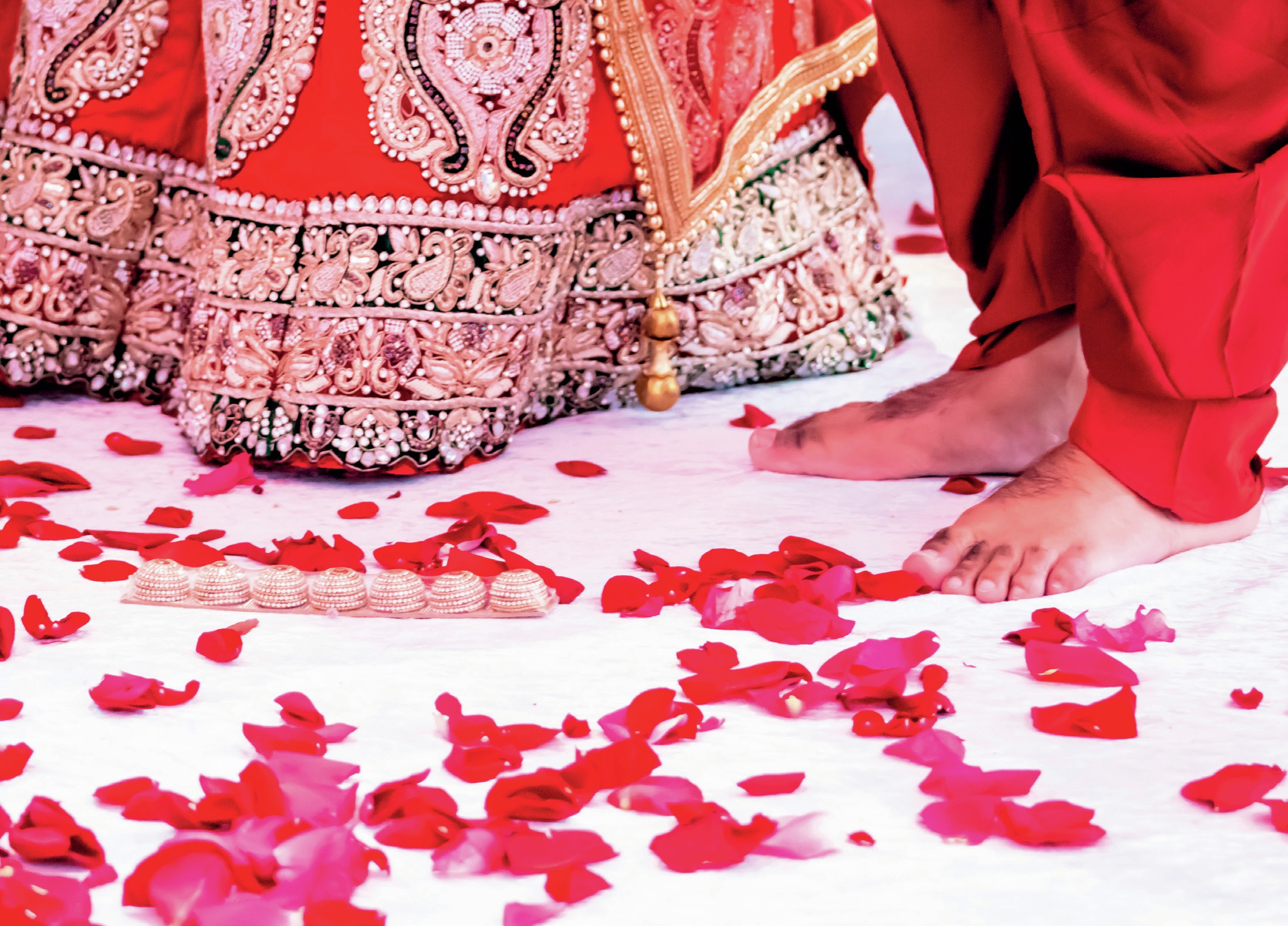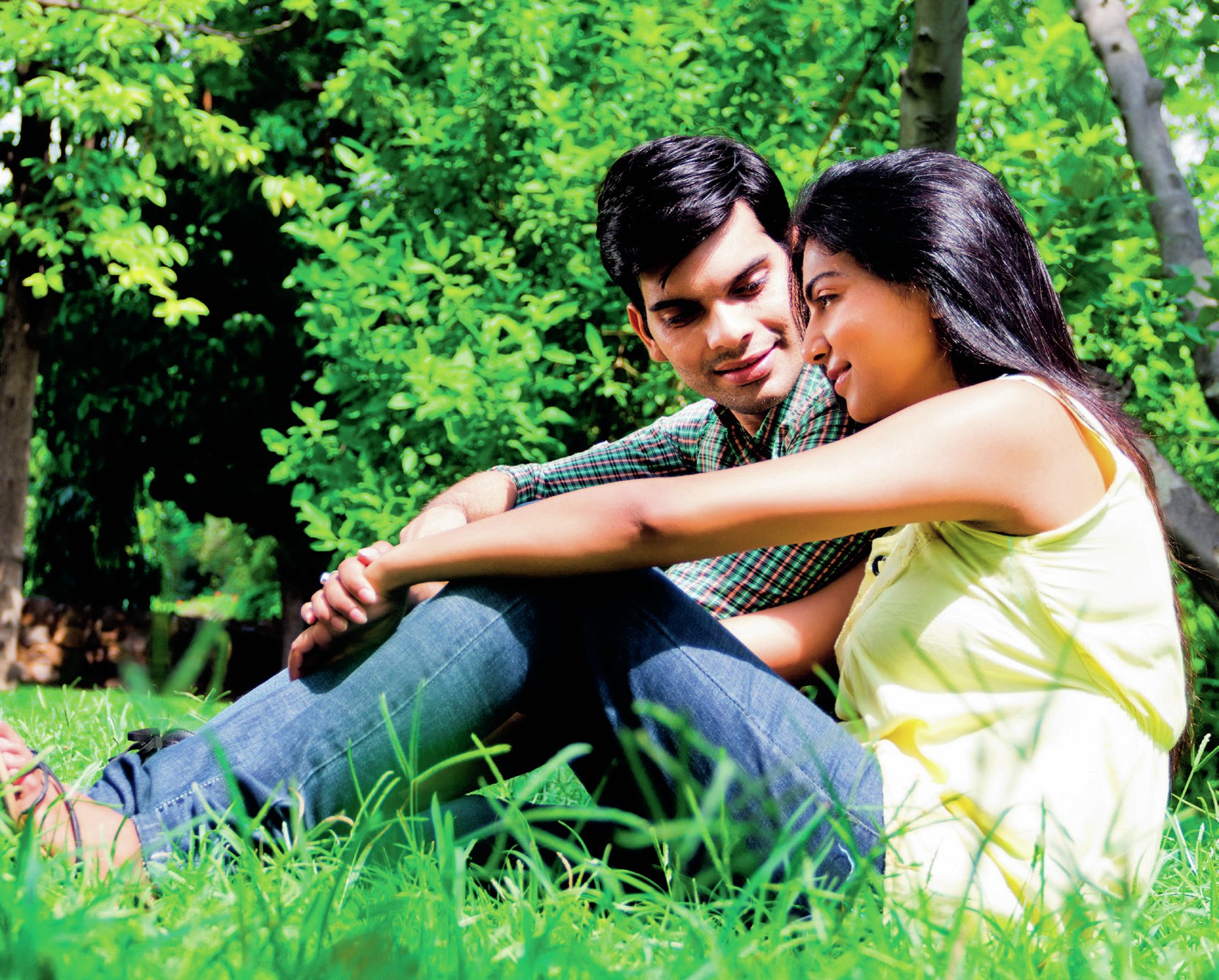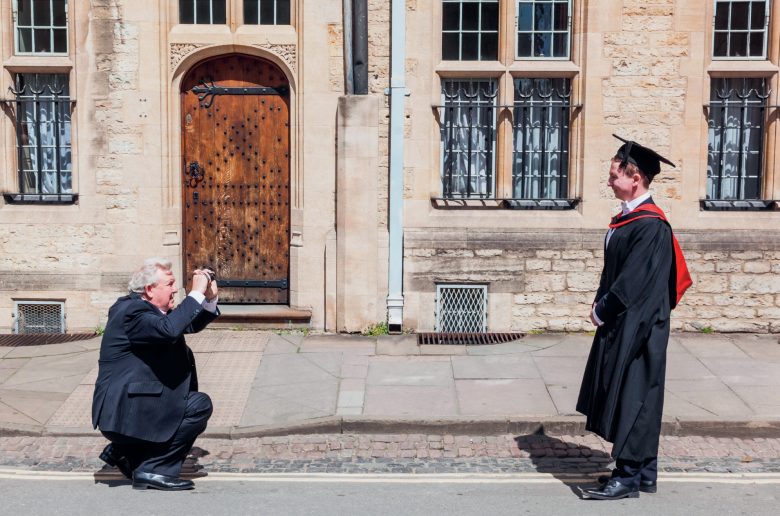The sociology of love and intimacy
A comparative study
Global ideologies of romantic love are valued among similar communities in both India and the UK, but they are interpreted and realised in different ways in each location.

EXAM LINKS
■ Families and Households
■ Culture and Identity
■ Methods
The study of love is perhaps not often thought of as an obvious choice for sociologists. Stevi Jackson (1995) argues that love is considered ‘too personal’ and too ‘individual’ to be studied by a discipline inherently interested in the social aspects of phenomena. However, as she also notes, other aspects of personal life, even sexuality (sexual practices, preferences and desires), have been studied quite extensively by sociologists.
Moreover, as all A-level students will know, one of the first published sociological studies, conducted by Emile Durkheim, examined the (presumed) highly personal topic of suicide (1897). My own suspicion is that love might be considered too imprecise or too ‘fuzzy’ an area of personal life to examine via empirical methods. It is also a topic which is not perhaps associated with the problem-focused approach often taken in sociological studies.
Love and everyday life
Nonetheless, sociologists are increasingly turning their attention to the many facets of intimate life — and for good reason. Love and intimacy are central to everyday life and wellbeing, and through studying love, one can come to understand how larger social forces impact on everyday experience.
For example, ethnographic research by Nancy Scheper-Hughes (1992) in the favelas of northeast Brazil showed how mothers’ love for their new-born babies was delayed or withheld in response to the high mortality rate of young babies, provoked by poverty and inequality. This work also shows that, contrary to popular discourses about the ‘naturalness’ of maternal love, ‘even’ love between a mother and child is influenced by social structures.
It should now be clear that sociologists tend to take a social constructionist perspective to understanding love. That is, love, like other emotions, is culturally learned and is diverse across different historical and geographical contexts. For some sociologists the practices and meanings associated with love differ. For example, various physiological phenomena (such as arousal) are experienced by all, but are interpreted differently by differently positioned people. For sociologists such as Arlie Hochshild (2003), the very feelings of love are different. My work tends to fall in this latter camp.

Global perspectives
When I first visited India as a student in my gap year, I thought of love as an emotion which was likely to be experienced, lived and felt in similar ways across the world. My friends in India very soon changed these ideas. On the one hand, they told me that they wanted to fall in love and experience romance. On the other hand, many planned to marry someone of their parents’ choosing via an arranged marriage.
For them, couple intimacy could not be disentangled from familial relations. I could not understand their perspectives. So a few years later, in 2006, I went back to a city called Baroda in Gujarat to find out what was going on. My interest at that point was how where one is brought up shapes how we experience intimate life, specifically couple relationships (see Box 1).
My interest was sparked by ‘love’ and its meaning to young people in Baroda, but I also considered my project as a case study on the effects of globalisation and transnationalism. That is, how are global ideologies (of love and romance) interpreted and lived out in two very different settings by members of the same cultural ethnic group?
Box 1 Methods
I chose an ethnographic approach and spent 9 months in India collecting the relationship views and experiences of heterosexual men and women aged between 20 and 30 years old. I interviewed newly married and unmarried men and women, and some older participants too, such as parents and matchmakers.
I spent time with old friends and sought out new people who could tell me their perspectives on love and marriage in a more systematic way. With pages of field notes and recorded interviews, I then returned to London and conducted similar fieldwork with Gujarati Indians brought up and living in the UK. Participants were mostly middle class and university educated. They were also mostly Hindu.
I confined my sample in these ways to avoid over-complication. This allowed me to compare how being brought up as ‘Gujarati’ in the UK, and also in a rapidly modernising India, impacts on relationship and marriage trajectories.
Love among Gujaratis in Baroda and London
I found that there were both similarities and differences between the relationship ideals and experiences of Gujarati participants in Baroda and London. In particular, participants from both cities valued love and intimacy in forming marital relationships, but the form of this love, and indeed of the marital relationships involved, differed according to the context.
First of all, in both London and Baroda, participants expressed a strong desire to marry someone they loved — whatever kind of marriage they had, or planned to have. For example, in Baroda, Hiren and Swati, a married couple who met through an arranged marriage process, told me that it was their ‘sixth sense’ that guided them through the selection process, and soon after their first meeting they told one another that they were in love. Several other arranged marriage couples described romantic engagement periods, filled with ‘dates’, love notes and flowers. Likewise, in the UK participants told me that they would only ever marry someone they loved, even if they described a more gradual process of getting to know a partner and falling in love.
Another similarity between participants in India and the UK was the importance of ‘endogamy’ (a preference to marry someone of a similar background or status), although small differences over what this meant emerged in the two contexts.
In India, participants were very open about their preference to marry someone Gujarati, someone of the same religion, and preferably someone of the same or a similar caste and class. It was taken for granted that a marriage between similar people would be more successful.
Seeta in Baroda, for example, told me a story about an affluent young girl who ran away with a rickshaw driver. The girl eloped to Mumbai, but her parents eventually found her and married her off to someone of their choosing. Far from sympathising with this girl, Seeta berated her for being so foolish and selfish. She felt the girl’s parents were justified in taking her back home and marrying her off to someone ‘more suitable’.
In the UK, participants professed to know very little about caste, but they did express a preference to marry a Gujarati, or at least another Indian. One participant told me that her father insisted that her future husband should come from a set of seven villages in rural Gujarat, which his forebears traditionally married from.
But a matchmaker I interviewed in London told me that while some parents and young people started looking for a spouse from the same caste, they soon changed their mind when they realised how small the pool was. Rather, they prioritised the ‘community’ — that is, the future spouse should be Gujarati — and class background. A preference to marry someone of a similar class background is not unusual in the UK (and other contexts), but unlike in India, such preferences are rarely explicitly expressed (McPherson et al. 2001).

In search of the perfect marriage
Despite these similarities, participants in the UK and India desired different kinds of marriage. In Baroda, an ‘arranged marriage’, where introductions are facilitated by parents, was generally preferred to a ‘love marriage’. In an arranged marriage, an individual will decide whether to go forward with a marriage after approximately two or three meetings with a potential spouse selected by (or with) parents. The level of choice and the number of potential partners which a person can meet depends upon the parents.
A ‘love marriage’ in Baroda was where a young couple may meet and decide upon marriage without the involvement or permission of their parents. The couple are likely to come from differing castes or religions. This latter kind of marriage is associated with a disregard for parental authority and tradition.
In general, a love marriage in Baroda was described as an ‘impermissible’ marriage, and participants preferred and anticipated a marriage arranged with their parents. Here Tarun explains why love marriage is not a good idea:
Love marriage is not a permissible marriage, so if any problem arise you cannot go to your father and mother [and say] ‘I have a problem so what I can do?’ […] Now in our society some people will do, but society will not agree with him. […] Permission is the main thing and, if any problem [the] main thing is [the] problem. I have seen two or three examples that after a love marriage so many problems occur. I don’t know why, but problems occur.
Having an arranged marriage did not stop participants from viewing their marriage, or future marriage as romantic. In particular, the period between initial introduction and the wedding was described as a highly romantic phase for the couple. For example, Aditya and Geet have, as they describe it, an ‘arranged marriage’. A common family friend facilitated their introduction. Aditya described his decision to marry Geet:
I had drawn some parameters because you cannot get everything. You just have to draw parameters and then choose from that which one suits you. That’s how I put down certain things and if these things come, I will go ahead…She [Geet] was more or less fitting into that parameter, and I decided to go further with her.
As with other participants, Adtiya’s portrayal of his decision to marry Geet is far from romantic and seems, in fact, much more strategic. But even as the selection is described in quite pragmatic terms, the period directly after choosing the future spouse, from selection to early marriage, was in contrast described as a time of romantic love-making.
Aditya and Geet warmly related their dating experiences between the introduction and marriage. Indeed, Geet told me: ‘I do not feel it was an arranged marriage; it was like a love marriage.’ My participants saw no contradiction in this rapid move from pragmatism to romance. As Rebhun comments, Western researchers:
tend to believe that sentiment is genuine only if it is spontaneous; conventional, required. Manipulated sentiment seems false…and its falseness [is] morally reprehensible… But deliberation and requirement are as much a part of emotion as spontaneity. (Rebhun 1999)
That is, actively choosing to fall in love does not negate the emotion involved.
Similar findings on ‘manipulated’ emotion have been uncovered by research in Brazil, South India, Micronesia and Iran.
Love and marriage in the UK
In the UK, participants expressed a strong preference for a ‘love marriage’ and being ‘introduced’ to someone by parents was considered a last resort. Their preferences were partially shaped by their position as minority ethnic individuals in the UK. They were clearly concerned to portray themselves as ‘modern’ British citizens, and they appeared concerned to differentiate themselves from more ‘traditional’ British communities, characterising arranged (and forced) marriage as being more common in those communities.
The autonomy of young people in making decisions around marriage is often associated with ‘modernity’ in popular discourse. How such discourses are interpreted in the UK is down to both the surrounding cultural context and the level of material independence young people have. Young people in the UK, more than in India, are more likely to be able to sustain themselves financially (see Twamley 2013).
Their preferences were also, however, related to their understanding of love as an irrational and overpowering force, linking love with ideals of ‘fate’ such as the ‘universe throwing two people together’ (Darsha). The ‘premeditated’ nature of an introduction process clashed with this ideology. As Mahendra, who is in a love marriage explains:
I don’t feel like a premeditated… process allows for a complete expression of yourself. It’s like a job interview […] If you meet enough people, you’re going to find somebody, and even find somebody you’ll have a wonderful relationship with, I’m sure. Millions of people have done it [….] I think you’ve got to meet a lot of people…to find, to get that right [one]. Just let natural attraction take you to somebody.

Conclusion
I found that global ideologies of romantic love hold salience for participants in both contexts, but they are realised in two very different ways. In India there is a high attachment to the discourse of love and the ongoing maintenance of more ‘traditional’ criteria of a good match. On the other hand, in the UK, media hype against ‘traditional’ Asian marriage practices encouraged these Hindi participants to portray their relationships as ‘modern’ love marriages, and to demonstrate a strong attachment to ideals of romantic love.
The study showed that, as popular as the global ideal of romantic love and modern intimacy might be, in practice local cultural norms shape its realisation, even among members of similar cultural backgrounds. Global ideologies are more likely to be ‘indigenised’ to create multiple local cultural forms (Appadurai 1994).
KEY POINTS
■ This is a comparative study of heterosexual couples in Gujarat and London, looking at attitudes to love and marriage.
■ The UK sample was taken from the Gujarati community in London, and matched the Indian sample in terms of education and class background.
■ Both groups held positive attitudes towards romantic love, but differed in their views on the best way of finding a marriage partner.
■ The respondents in Gujarat generally felt that it was important that others, especially parents, should be involved in the process of finding a suitable mate, while those in London expressed a desire for autonomy and independence when choosing a partner.
■ Both groups were in favour of endogamous marriage — that is, marrying someone of a similar background to oneself.
■ The research showed that, even among groups with many common characteristics, the culture in which a person is brought up can result in very different views of love and marriage.
RESOURCES
Appadurai, A. (1994) ‘Disjuncture and difference in the global cultural economy’ in P. Williams and L. Chrisman (eds) Colonial Discourse and Post-Colonial Theory: a reader, Harvester Wheatsheaf.
Hochschild, A. R. (2003) The Managed Heart: the commercialisation of human feeling, University of California Press.
Jackson, S. (1995) ‘Even sociologists fall in love: an exploration in the sociology of emotions’, Sociology, Vol. 27, No. 2, pp. 201–20.
McPherson M., Smith-Lovin, L., Cook, J. M. (2001) ‘Birds of a feather: homophily in social networks’, Annual Review of Sociology, Vol. 27, pp. 415–44.
Rebhun, L. A. (1999) The heart is unknown country: love in the changing economy of northeast Brazil, Stanford University Press.
Scheper-Hughes, N. (1992) Death Without Weeping: the violence of everyday life in Brazil, University of California Press.
Twamley, K. (2013) ‘The globalisation of love? Examining narratives of intimacy and marriage amongst middle-class Gujarati Indians in the UK and India’, Family, Relationships and Societies, Vol. 2, No. 2, pp. 267–83.





